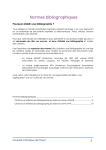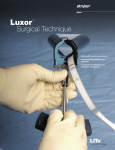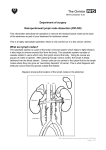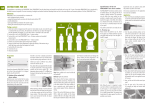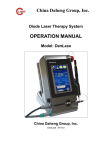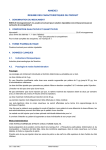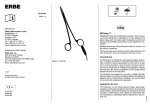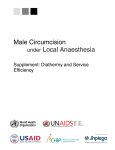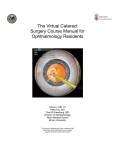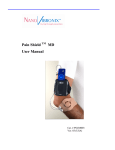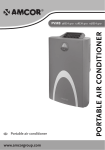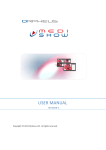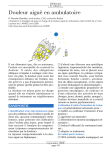Download User Manual for Authorized & Trained Users Only Intended use
Transcript
1 User Manual for Authorized & Trained Users Only Intended use: PrePex is a single use, disposable device; indicated for circumcision of adult men, defined as circumferential excision of the foreskin or prepuce at or near the level of coronal sulcus, with minimal amount of preputial skin remaining. Contraindications: Dermatitis of the penis or foreskin, allergy to rubber, non -intact skin on the penis or foreskin, active genital infection, warts on the glans or the inner surface of the foreskin, anatomic abnormality including phimosis, paraphimosis, torn or tight frenulum, hypospadias, epispadias, any active penile diseases, active infectious disease impairing health, history of bleeding disorders, narrow foreskin opening. Disposal: Follow local, state and federal regulations with respect to environmental protection when disposing of general and infectious waste. If there are no regulations, the infectious waste, including all device elements, tools and materials that came in contact with the body or with body fluids should be incinerated. Other general waste should be segregated and stored in bins marked "General". The waste should then be buried in a designated area. Caution: The device should not be used if the package has been compromised. Use by trained personnel only. All device components should not be reused at the risk of cross contamination. The device is intended for adults only and is not applicable for males under the age of 18. The device should be used only in settings where suitable surgical facilities and skills are available within a short time frame (6-12 hours) in order to manage potentially serious complications resulting from device displacements. Device displacement when wearing the device, may lead to the risk of adverse events. Informing the patient of safe behavior when wearing the device is critical. Clinical Experience: Three clinical studies of PrePex were performed in Rwanda according to the WHO official Evaluation Framework of Adult Male Circumcision (MC) Devices1. 1. A study that demonstrated the safety & efficacy of the PrePex device in 105 male subjects2. Results: All subjects achieved circumcision with 1 case of diffuse oedema after device removal, which resolved with minimal intervention. Pain was minimal with brief discomfort during device removal. The entire procedure was bloodless, requiring no anesthesia, no suturing, and no sterile settings. Subjects had no sick/absent days associated with the procedure. Median time for complete healing was 21 days after device removal. There were no instances of erroneous placement and no mechanical problems with the device. Conclusion: The PrePex device was found to be safe and effective. 2. Randomized controlled study, comparing the safety and efficacy of the PrePex in 144 adult male subjects to a surgical circumcision method in 73 adult male subjects3. Results: All subjects were circumcised in 10 working days. The nonsurgical MC mean procedure time of 3.1 minutes (skin to skin), was significantly shorter than the mean surgical procedure time (15.4 minutes skin to skin) (P , 0.0001). There were no device-related adverse events. Healing time of the PrePex arm was longer than the surgical arm. Conclusion: PrePex nonsurgical MC, takes significantly less time than surgical, is as safe, does not require injections or sterile settings, is bloodless and seems to be suitable for nurses. 2 3. A Cohort field study that demonstrated the safety and efficacy of the PrePex on 518 adult males, when the procedure is performed by nurses4. Results: All 518 subjects from the pilot and pivotal phases achieved complete circumcision. There were 5 AEs on 4 subjects (rate of 0.96%, 95% Confidence Interval: 0.31-2.24). AEs were moderate and were resolved with simple intervention. Conclusions: The study demonstrated that nurses can be easily trained to perform safe and effective circumcisions using the PrePex device. Environmental Requirements and Storage Conditions: Storage: -10ºC to 55ºC, away from direct sunlight, humidity up to 80%. Shelf Life: The PrePex has a shelf life of 3 years. Device Overview: PrePex includes the following items: 1. Placement Ring 2. Elastic Ring 3. Inner Ring 4. Verification Thread Leg figure 1 – PrePex components Accessoires: The PrePex Sizing Plate (PSP) is intended for single use for selecting an appropriate device size. figure 2 – The PrePex Sizing Plate (PSP) The use of PrePex requires additional tools and materials which are not supplied with PrePex. For Placement: Examination Gloves, Antiseptic solution, Skin Marker, Gauze, 5% Anesthetic Cream and Nurse Utility Scissors. For Removal: Examination Gloves, Antiseptic solution, Sterile Harvey Wire Scissors, Sterile Forceps, Sterile Spatula, Sterile Scalpel, 2 Wound dressings, Nurse Utility Scissors and a Cutter. Patient Screening: Before performing the procedure, screen the patient for any contra indication, and physically test if the opening of the foreskin is wide enough for the PrePex procedure. Perform the test with examination gloves. Stretch the foreskin as described in step 6 of the Placement procedure below, and visually asses the flexibility of the foreskin and the opening. If there is phimosis or tight frenulum (i.e. the opening is not wide enough for the Inner Ring insertion), the patient should be contra indicated for PrePex. Gently pull down the foreskin to expose the sulcus and examine whether the foreskin is tight in the area below the sulcus. If the foreskin is tight in the area below the sulcus, the patient should be contra indicated for PrePex. 3 Patient Preparation: During the PrePex MC procedure, providers should wear examination gloves. Prepare the skin with antiseptic solution, starting with the glans and the shaft of the penis, and moving out to the periphery, as per the WHO Manual for Male Circumcision Under Local Anesthesia 5. Use a new, single use PrePex Sizing Plate (PSP). Select the appropriate size A, B, C, D, or E by sliding each opening of the PSP over the glans and placing it directly under the coronal sulcus. The appropriate size is the opening which fits best. (figure 3) Choose PrePex based on the sizing outcome (A, B, C, D or E). Type Diameter Catalog # A 26mm DW0201 B 28mm DW0202 C 30mm DW0203 D 32mm DW0204 E 34mm DW0205 figure 3 Note – If the diameter under the coronal sulcus is too large and it cannot fit in to the E opening or if it is too small and it cannot fit precisely to size A, do not perform the PrePex procedure and refer the patient to surgical circumcision. Procedure preparation: figure 4 figure 5 1. Mark the outer circumcision line according to the WHO Manual for Male Circumcision Under Local Anesthesia5 (Chapter 5-15, and Fig 5.17, Chapter 5-27 and Fig 5.33 and Fig 5.34) using a standard medical skin marker only (figure 4). 2. This step is common to all of the methods of circumcision. Stretch the foreskin past the glans and release. When the foreskin has returned to a natural “resting” position, indicate the intended line of the circumcision with a skin marker. The line should correspond with the corona, just under the head of the penis. Some uncircumcised men have a very lax foreskin, which is partially retracted in the resting position. In such cases it is better to apply a little tension to the foreskin before marking the circumcision line. However, it is important not to pull the foreskin too hard before marking the line, as this will result in too much skin being removed. 3. Mark the intended circumcision line, as described above, with a V shape, pointed towards the frenulum, on the underside (ventral aspect) of the penis (figure 5). The apex of the V should correspond with the midline raphe. Make sure the V shape is not too sharp. Make sure that the marked circumcision line will not be erased during the PrePex procedure. If the marking is not clearly visible do not perform the procedure. Before continuing it is very important to mark the line again, if necessary 4. After verifying that the line marking is clear, pull the foreskin down towards the body and apply 1gr of 5% anesthetic cream on the exposed shaft area up to the coronal sulcus. Once the anesthetic cream has been applied, there is no need to wait for the anesthetic cream to take effect and the procedure can commence immediately. 4 Placement Procedure: 1. Place the Elastic Ring on the Placement Ring (see figure 6). Do not remove the Verification Thread; it is intended to correct Elastic Ring misplacement. figure 6 2. Place the Placement Ring (with Elastic Ring in place) on the penis shaft with the Elastic Ring side facing away from the body (See figure 7). Steps 3 and 4 should be performed by 2 people. 3. The first person should stretch the foreskin up and to the sides for insertion of Inner Ring, holding the foreskin dorsal figure 7 and ventral sides. Use fingers or a dry gauze for a good grip (See figure 8) Ensure that the foreskin is fully stretched by viewing the sulcus area, thus assuring Frenulum there will be no double entrapped foreskin. 4. The second person should insert the Inner Ring with its flat parts toward the dorsal and ventral penis sides into the figure 8 opening of the foreskin (see figure 9), assuring that one of the flat sides is in the area of the frenulum and the other flat side is on the opposite side of the frenulum. 5. Warning: When introducing the Inner Ring through the foreskin opening, be very careful not to harm the foreskin. If it is impossible to introduce the Inner Ring do not perform the procedure. Frenulum 6. Introduce the Inner Ring over the glans and place it just below the glans (on the sulcus). 7. Hold the foreskin closed at the tip of the penis to secure the Inner Ring in place (See figure 10). figure 9 Advance the Placement Ring and Elastic Ring towards the glans until you can visually see that the Elastic Ring is circumferentially just over and inside the Inner Ring groove and that the Elastic Ring and Inner Ring are aligned 8. Once the Elastic Ring and Inner Ring are figure 10 aligned, with one hand support the Placement Ring, with the other hand adjust the foreskin so the marked Leg circumcision line is exactly underneath the Elastic Ring. Adjust the foreskin from beneath each of the 4 Legs by pulling the skin downwards (See figure 11). 9. To place the Elastic Ring - Using 4 fingers of your dominant hand hold the Elastic figure 11 Ring and Inner Ring together in the space between each of the 4 Placement Ring Legs. Work with the thumb and finger of your non dominant hand to release the Elastic Ring from one Placement Ring Leg at a time (figure 12). 10. Make sure the Elastic Ring is mounted directly over the Inner Ring groove and above the marked circumcision line figure 12 previously marked. If the Elastic Ring is not positioned as desired or if you identify that there is double entrapped foreskin, use the verification thread to pull it off the penis and start the procedure again. 5 11. Upon proper placement of the Elastic Ring, discard the Placement Ring, and cut the verification thread with the nurse utility scissors 12. Supply the patient with 2 tablets of 400Mg ibuprofen or other painkillers tablets and Post Placement information. Instruct the patient on the following before sending him home: a. Not to move the Device, not even through clothes – emphasize that touching the device while urinating or bathing must not cause any movement of the device. Any movement of the device may lead to surgical MC. b. To return for device removal after 7 days. Early removal may result in surgical MC. c. To return to the MC center if he wants to remove the device before the 7 days period is over. d. Not to remove the device and not to let anyone other than the designated provider to remove the device. e. To report any unexpected situation, such as uncontrollable pain or device displacement. f. Not to pull on the foreskin in case partial detachment g. To abstain from sexual intercourse and to avoid masturbation when the device is on the penis, so it will not move out of place. Inform the patient of the following when sending him home: a. He may experience pain in the following weeks, and he should take the supplied painkiller tablets to control the pain. b. The foreskin distal to the Elastic Ring will become darker and dry. c. Unpleasant odor may occur while wearing the device. d. Infection may occur while wearing the device. e. There may be some partial skin detachments along the Elastic Ring. f. He should bath normally and keep the inner foreskin clean. The area should be rinsed thoroughly (holding the source of water close to the penis and directing the water stream to the foreskin opening) without touching and/or displacing the device in any way. Foreskin Removal: figure 13 figure 14 1. The device is removed 7 days after it has been placed. 2. It is recommended to use sterile Harvey wire cutting scissors (figure 13), due to their blunt edges and serrated blades, specifically designed to cut tough tissue like the dried necrotic foreskin. 3. Before removing the foreskin it is recommended to pull the penis and foreskin gently upwards to separate the foreskin from the glans. You may drip fluids (e.g. Antiseptic solution) through the foreskin opening to enhance this separation. 4. Warning: Take care not to injure the urethra through introduction of wire cutting scissors into the meatus or lacerate the glans by not holding the foreskin far enough away from it when cutting. 5. If the opening of the foreskin is very narrow, you should dilate it gently with the forceps tip to allow insertion of one of the wire cutting scissors blade. Use sterile forceps to hold the foreskin and to pull it away from the glans. 6. The foreskin should be cut first vertically toward the Elastic Ring and then with an angle, spirally, to the line that the Inner Ring is visible (figure 14). 7. Cut the foreskin as close to the Elastic Ring as possible, so that the tip of the Inner Ring becomes visible. 6 Elastic Ring Removal: figure 15 8. Warning: Elastic Ring should be removed only after the foreskin has been removed. 9. Use a sterile scalpel to cut the Elastic Ring placed over the flat part of Inner Ring on the side that is opposite the frenulum. Do not cut the Elastic Ring 10. on the same side as the frenulum (Figure 15). 11. Take care not to harm the viable skin. 12. Discard Elastic Ring. Inner Ring Removal: 1 2 3 4 figure 16 1. The Inner Ring is removed after the Elastic Ring removal. 2. Use a sterile spatula to separate the necrotic foreskin all around the Inner Ring. 3. Pull the Inner Ring out on a curved side using the spatula; take care to avoid the frenulum (figure 16). 4. Partial separation of the necrotic foreskin may occur, in such cases extra care should be taken when extracting the Inner Ring to minimize pain at the separation area. 5. Cut the Inner Ring with a cutter before discarding it. Post Removal Procedure: figure 17 1. Clean the circumcised penis with antiseptic solution. 2. Dress the circumcised penis with a standard non adherent pad. 3. Instruct the patient not to wet the dressing for 2 days. 4. Supply the patient with a new dressing to take home and instruct him that in case the dressing on the penis gets wet he should remove it and replace it with a new dry dressing. 5. Instruct the patient to remove the dressing completely in 2 days, at which time he can wash the penis and the wound area normally. 6. Instruct the patient to contact the MC clinic in case of pain, infection, swelling or fever. Inform the patient that all of those risks may occur following device removal. 7. Instruct the patient to abstain from sexual intercourse for 6 weeks after device removal and to avoid masturbation, and that those actions may lead to disruption of the wound which will result in delayed healing. 8. Explain to the patient the importance of using condoms, and that circumcision is not a complete protective solution for the prevention of HIV infection. 7 Procedure and Device Associated Risks: The following possible risks may occur while the patient is wearing the PrePex: x Patient displacing the device from its original position may lead to pain and to diffuse oedema that will require surgical MC. To mitigate such risks it is essential to explain to the patient that he should not move the device even if he has pain or discomfort, and he should not masturbate or have sex. In case of pain the patient should take the supplied painkiller tablets. If the pain is uncontrollable, the patient should return to the MC center to be evaluated and clinically managed. Early controlled removal of foreskin and device may be indicated. If there is displacement of the device with or without oedema, the patient should return to the clinic as soon as possible where the provider may recommend surgical circumcision to avoid serious and possible life threatening infection. Surgical circumcision should be performed within 6-12 hours after displacement. The following possible risks may occur as a result of misusing the device by provider: x x x x If the Inner Ring is not pushed all the way down to the sulcus level this may lead to disturbance of urine flow. If the Inner Ring is not pushed all the way down to the sulcus level this may lead to insufficient removal of foreskin. If the circumcision line is not marked according to recommendations presented in this document, this may lead to removal of too much foreskin and future problems with penile function, or to removal of insufficient skin. Penile injury during foreskin removal due to misuse of the wire cutting scissors. Other possible risks: x x x x x x x Device displacement and oedema requiring urgent surgical circumcision. Bleeding after device removal. Pain – mainly 2 days after Placement procedure. Infection while wearing the device and after removal. Delayed healing. Injury to the penis particularly during removal. Unpleasant odor while wearing the device. It is important to report any complaint or incident occurring with the device to the manufacturer Circ MedTech, by Email or phone as soon as possible. Training: To receive complete training materials, including presentations and videos, send an E-mail to info@prepex.com requesting the training material and a CD will be sent as soon as possible. 8 References: 1. World Health Organization. Framework for Clinical Evaluation of Devices for Adult Male Circumcision. Geneva, Switzerland; WHO; September 2012, 2. Bitega JP, Ngeruka ML, Hategekimana T, Asiimwe A, Binagwaho A. Safety and efficacy of the PrePex device for rapid scale up of male circumcision for HIV prevention in resource-limited settings. J Acquir Immune Defic Syndr. 2011;58; E127–E134. 3. Mutabazi V, Kaplan SA, Rwamasirabo E, et al. HIV prevention: male circumcision comparison between a nonsurgical device to a surgical technique in resource-limited settings: a prospective, randomized, nonmasked trial. J Acquir Immune Defic Syndr. 2012:61; 49-55 4. Mutabazi V,Kaplan S. A, et al. One Arm, Open Label, Prospective, Cohort Field Study to Assess the Safety and Efficacy of the PrePex Device for Scale Up of Non-Surgical Circumcision when Performed by Nurses in Resource Limited Settings for HIV Prevention, J Acquir Immune Defic Syndr, Publish Ahead of Print, March 2013 5. World Health Organization. Manual for Male Circumcision Under Local Anesthesia, Geneva, Switzerland; WHO; version 3.1.December 2009. Must Consult Instructions for use Product meets the Requirements of the applicable European Directive. Do not reuse Circ MedTech Limited Hahoshlim st. 6 Herzelia, 46722 Made in Israel Phone +972776935607 info@prepex.com www.prepex.com -10 MedNet GmbH; Borkstrasse 10; 48163 Muenster; Germany Phone +49 251322660 55°C °C PN-00111-Rev 12, Release 29 May 2013








